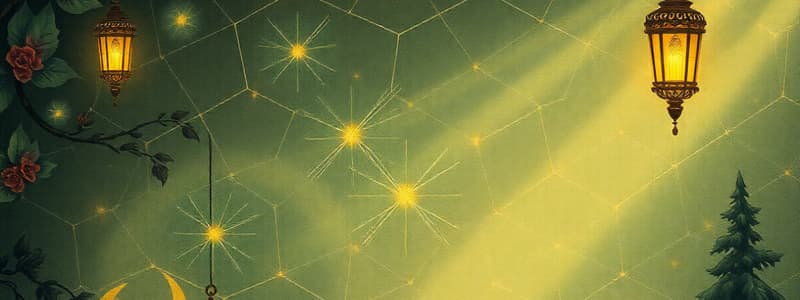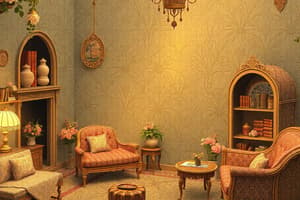Podcast
Questions and Answers
What does the aesthetic function of art primarily focus on?
What does the aesthetic function of art primarily focus on?
- Conveying ideas and beliefs
- Creating functional objects
- Expressing beauty (correct)
- Evoking emotions
Which of the following best describes the psychological function of art?
Which of the following best describes the psychological function of art?
- Creates political symbols
- Evokes and conveys emotions (correct)
- Encourages cooperation
- Manages cultural heritage
Which function of art involves educating as well as entertaining the audience?
Which function of art involves educating as well as entertaining the audience?
- Communicative Function
- Didactic Function (correct)
- Psychological Function
- Aesthetic Function
What is primarily indicated by the social and political function of art?
What is primarily indicated by the social and political function of art?
What is a primary characteristic of an artisan in the context of art?
What is a primary characteristic of an artisan in the context of art?
Which of the following illustrates the scientific aspect of art?
Which of the following illustrates the scientific aspect of art?
Which of these options does NOT typically represent a function of art?
Which of these options does NOT typically represent a function of art?
What role does a curator play in the context of the arts?
What role does a curator play in the context of the arts?
What defines visual or space arts?
What defines visual or space arts?
Which of the following is an example of auditory arts?
Which of the following is an example of auditory arts?
What does distortion refer to in art?
What does distortion refer to in art?
Which of the following best describes elongation in art?
Which of the following best describes elongation in art?
What is a defining characteristic of Cubism?
What is a defining characteristic of Cubism?
Which term describes art that reacts against realistic depictions of nature?
Which term describes art that reacts against realistic depictions of nature?
What characterizes the art movement of Fauvism?
What characterizes the art movement of Fauvism?
What did the Dada movement primarily reject?
What did the Dada movement primarily reject?
Which art form combines both visual and auditory elements?
Which art form combines both visual and auditory elements?
Which artistic style seeks to capture transient effects of light and color?
Which artistic style seeks to capture transient effects of light and color?
What was the main focus of Expressionism in art?
What was the main focus of Expressionism in art?
What is the main focus of combined arts?
What is the main focus of combined arts?
What aspect of modern life is emphasized in Futurism?
What aspect of modern life is emphasized in Futurism?
Pointillism is characterized by which technique?
Pointillism is characterized by which technique?
Surrealism was a reaction against what cultural influence?
Surrealism was a reaction against what cultural influence?
What was the goal of the Futurism movement as articulated by Filippo Tommaso Marinetti?
What was the goal of the Futurism movement as articulated by Filippo Tommaso Marinetti?
Which color is typically associated with passion and aggression?
Which color is typically associated with passion and aggression?
What term describes the space occupied by objects in an artwork?
What term describes the space occupied by objects in an artwork?
Which principle of design involves creating a focal point in an artwork?
Which principle of design involves creating a focal point in an artwork?
What does linear perspective create in an artwork?
What does linear perspective create in an artwork?
Which element best describes how light and dark areas in an artwork are used?
Which element best describes how light and dark areas in an artwork are used?
In design, what is rhythm created by?
In design, what is rhythm created by?
What does balance refer to in the principles of design?
What does balance refer to in the principles of design?
Which technique uses overlapping objects to create depth in artwork?
Which technique uses overlapping objects to create depth in artwork?
What is the primary way an artist communicates through art?
What is the primary way an artist communicates through art?
Which of the following best describes representational arts?
Which of the following best describes representational arts?
What does the term 'medium' refer to in the context of art?
What does the term 'medium' refer to in the context of art?
Which level of meaning in art refers to personal interpretation by the artist?
Which level of meaning in art refers to personal interpretation by the artist?
What is a distinguishing feature of abstract art?
What is a distinguishing feature of abstract art?
Which of the following subjects is commonly explored in representational art?
Which of the following subjects is commonly explored in representational art?
How can art stimulate the senses?
How can art stimulate the senses?
What is meant by the term 'subject' in art?
What is meant by the term 'subject' in art?
Flashcards are hidden until you start studying
Study Notes
Nature and Functions of Arts
- Practical Function: Art serves everyday purposes, such as the functionality of furnaces.
- Aesthetic Function: Focus on beauty and judgements of taste; it is a branch of philosophy concerned with beauty.
- Psychological Function: Art evokes emotions and conveys feelings.
- Religious Function: Utilized for worship and spiritual expression.
- Social and Political Function: Acts as a symbol of unity among people.
- Greek Golden Ratio: Mathematical measure used to evaluate perfect beauty; Amber Heard's face rated at 91.85% accuracy, while Kim Kardashian ranks second for beauty.
Conceptual Understanding of Art
- Artists vs. Artisans: Artists create art through various means; artisans are skilled craft workers making handmade objects, which can be functional or decorative.
- Curator: A manager overseeing cultural heritage, responsible for maintaining art collections.
- Art as a Science: Studies aspects such as psychology, sociology, and the history of arts while applying principles of beauty.
Characteristics of Art
- Creation: Involves re-ordering existing materials; requires planning, creativity, and collaboration.
- Expression: Artists communicate emotions, values, and hidden realities through their work.
- Experience: Reflects what artists gain from life experiences.
- Artificial: Art is a duplication of nature, contrasting with natural and disorderly elements.
Art Responses
- Sensory Response: Engages the senses through visual or auditory elements.
- Intellectual Response: Stimulates critical thinking and analysis.
Subjects in Art
- Two Types of Subjects:
- Representational/Object Arts: Arts depicting particular subjects.
- Non-Representational/Non-Objective Arts: Arts lacking specific subjects.
Common Themes in Art
- Most Used Subjects: Landscapes, everyday life, portraits, legends, and dreams.
- Content vs. Subject: Subject refers to what is presented, while content refers to its meaning.
Levels of Meaning in Art
- Factual Meaning: The literal interpretation of an artwork.
- Cultural Meaning: Significance conveyed to specific cultural or social groups.
- Subjective Meaning: Personal interpretation based on the artist's perspective.
Mediums of Art
- Definition: Materials and means used by artists to convey feelings or thoughts.
- Types of Arts:
- Visual/Space Arts: Seen in two-dimensional (painting) or three-dimensional (sculpture) forms.
- Auditory Arts: Experienced through sound (e.g., music, literature).
- Combined Arts: Incorporates elements of both seen and heard (e.g., dance, opera).
Art Styles and Techniques
- Art Style: Characteristic features defining a person, group, movement, or time period.
- Art Techniques: Methods and procedures utilized in creating art.
Specific Art Movements
- Expressionism: Captures subjective emotions rather than objective reality.
- Futurism: Celebrates speed, energy, and the dynamism of modern life.
- Impressionism: Focuses on capturing transient effects of light and color.
- Surrealism: Challenges rationality and embraces the fantastical and irrational.
- Dadaism: Rejects traditional art concepts in favor of chaos and anti-bourgeois sentiment.
Principles of Design
- Emphasis: The focal point drawing attention within an artwork.
- Contrast: Utilizing distinct elements, such as light and dark, for visual interest.
- Rhythm and Repetition: Creates a sense of movement through repeated design elements.
- Balance: Distribution of visual weight for stable composition.
- Movement: Guides the viewer's eye throughout the artwork.
Elements of Art
- Color Associations:
- Red: Passion and aggression.
- Yellow: Appetite and cheerfulness.
- Blue: Calmness and infinity.
- Green: Freshness and renewal.
- Space: The effective use of positive (filled) and negative (empty) areas in composition.
- Form and Value: 3D representation of shapes and the lightness/darkness of artwork sections.
- Texture: Simulation of how a surface feels or appears to feel.
Advanced Concepts
- Abstraction: Moving away from representational forms; involves simplified shapes and concepts.
- Distortion and Elongation: Altering shapes to express ideas or emotions.
- Symbolism: Art that conveys deeper meanings beyond literal interpretations.
Studying That Suits You
Use AI to generate personalized quizzes and flashcards to suit your learning preferences.




